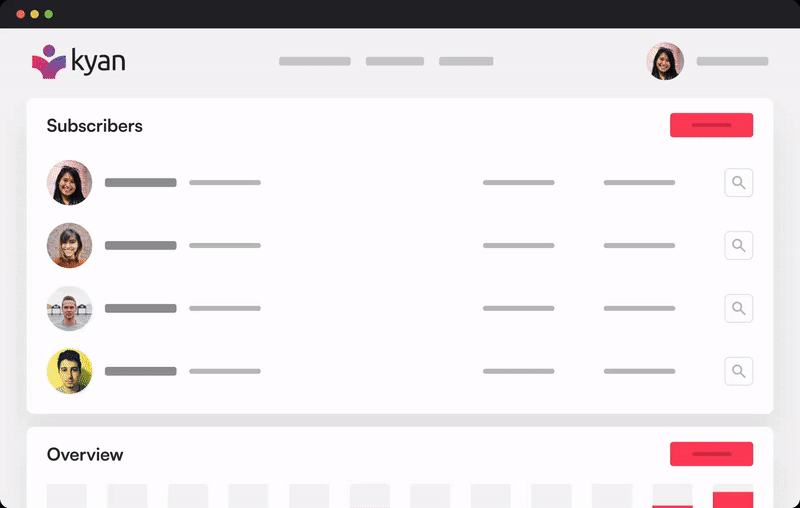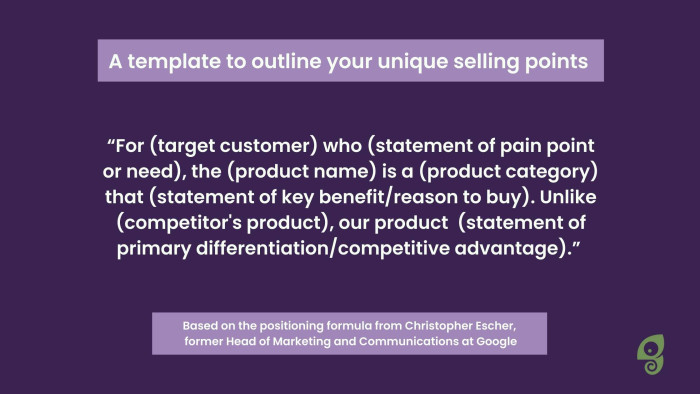The most common mistake when it comes to launching a new product is jumping straight to the logistics before understanding where and how your product will fit into the market. This can lead to ineffective messaging, poor sales, and a disjointed product marketing strategy. If you haven’t been focusing on product positioning from day one, now’s the time to adapt your process.
Here is a short summary video to get you started:
Product positioning is a part of your product marketing strategy that is evident mainly through messaging - it defines where your product fits into the market and how it communicates with its target audience.
A poorly positioned product will suffer from missed sales opportunities and can hurt a company's reputation, while a well-positioned product will generate more success.
You can find out whether your product is well-positioned by asking your customers directly through contextual feedback collected through every stage of their lifecycle.
There are 5 basic steps you can take to develop effective product positioning strategies: conduct market research, analyze the competition, define your target audience, determine your competitive advantage, and craft your key messaging statements.
Your product positioning strategy needs to be clearly defined in your unique value proposition, mission and vision statements, tagline/slogan, and elevator pitch.
What is product positioning?
Product positioning is the strategic planning of where your product fits into the market, and how you will communicate your unique value to your target audience. As one of the most critical steps for long-term success, positioning establishes how your product differs from competitors and why your customers need it. It’s a form of marketing represented through messaging.
In other words, accurate product positioning stops a company from releasing a product as X, but customers viewing it as Y. It ensures that the message the product conveys is the same as the one perceived by your target audience.
Why positioning matters so much
First and foremost, product positioning can directly affect sales. A product with poor positioning is unlikely going to generate sufficient sales due to misunderstood messages or missed opportunities. This could potentially even damage a company’s reputation.
On the other hand, a well-positioned product shows a good understanding of customer needs and conveys a clear message which leads to more satisfied users and, eventually, to more upselling opportunities.
The process of positioning is also valuable for product marketing teams to help them understand where the product is now and where it should go, thus influencing future product development and marketing strategies.
Is your product already positioned well? Let’s find out.
Establishing whether a product is positioned well isn’t easy. Many product teams make the mistake of keeping the analysis in-house, adopting the “if we get it, then our users will get it, too” mentality.
But the best way to truly determine the effectiveness of your product’s positioning is to ask your customers directly.
Collecting contextual customer feedback—from all touchpoints within the user journey—allows you to gain valuable insights into what the customer is thinking and feeling during their interaction with your product. This will also help you better understand how your users perceive your product.
You can start by asking these questions:
Do your customers truly understand your product’s purpose?
Is it clear what problems and pain points your product solves?
Are your customers aware of all the benefits they could get?
Is your product set apart from the competition clearly enough?
Why should the users choose your product over competitors?
Remember, customers aren’t as intimately acquainted with the design and development of your product as you are. So, if they answer positively to these questions and they can clearly articulate the difference between your products and competition, you’ve done a good job with positioning.
If not, in addition to talking to customers, you can also analyze the product usage data to gain valuable insights. And, you can try asking your product team the same questions, but be sure that everyone is as objective as possible.
By asking the right questions and using quantitative or qualitative research to seamlessly implement user feedback throughout the product lifecycle, you can ensure that your product positioning stays in line with your brand values.
👉 Explore this interactive demo to see how Chameleon Microsurveys help streamline in-app feedback.

Create Microsurveys for continuous in-product feedback
Easily build no-code in-app surveys to collect contextual and targeted user feedback. Try for free.
Benefits your SaaS business can gain from product positioning
There’s a reason product positioning is considered one of the most critical aspects of product marketing—it gets tangible results.
For a SaaS business, effective product positioning leads to:
Generating more highly qualified leads
Prioritizing your leads more effectively
Creating more detailed user segmentation
Improved product adoption rates
Increased user retention rates
Another important outcome you’ll see from carefully thought-through product positioning efforts is communicating the right message to the right people, at the right time. This is especially relevant if you serve different audience groups (e.g. individual users and enterprise-level customers).
How to do it right: 5 steps to an effective product positioning strategy
Step #1: Conduct market research
A key aspect of product marketing is knowing where your product stands within the market. The first stage to developing an effective product positioning strategy is to evaluate your market as a whole through market research.
Understand:
Where does your product sit within the market?
What demand is there for your product?
Who are your main competitors?
Are they above or below you in terms of market share?
What trends exist within the space and how your product fits?
Step #2: Analyze competition
Once you’ve established the product-market fit, it’s time to take a closer look at your competitors.
Look at:
Their product offering (are there different pricing plans, access levels, feature upgrades, etc.)
Who their target customers are
Which marketing channels they’re using (i.e. social media, Google Ads, etc.)
How similar is their offering to yours
What their reputation is like (authority, quality, customer service, etc.)
Step #3: Define your target audience
Next, review any existing customer data if applicable and draw up a list of traits for your ideal customer persona. Define your target audience demographically and identify possible wants, pain points, and needs they might have.
Establish:
Age
Location
Gender
Income
Educational level
Try also to determine their existing knowledge about your product’s niche, as well as their interests, habits, attitudes, and opinions.
Step #4: Determine your competitive advantage
After analyzing your competition, identify how your offering differs. Define your unique value proposition (UVP) and tailor it to your target customers. Make this the focus of your marketing campaigns.
Include:
Price points
Ease of use (design, level of knowledge required, etc.)
Innovative features
Upgrade potentials
Compatibility
Industry-specific solutions
Step #5: Craft your key messaging statements
Now that you know who your ideal customers are, what solutions they’re looking for, where your product sits in the market, and what your competitors are doing, it’s time to pull this information into your messaging statements.
To effectively position your product, you need to focus on its unique selling points. The template below serves as a helpful guide to build on.

You don’t have to follow this word for word, and you don’t have to name competitors individually. Try to find a unique angle, keep your audience in mind, and incorporate the core elements into your statement.
Here’s an example of what this might look like, using Chameleon as the product.
“Are you a B2B SaaS company looking to boost engagement and help your users get the most of your product? Chameleon’s no-code builder enables you to create custom onboarding flows that fit your user journeys and integrate seamlessly into your product. You'll stand out from the crowd while your in-app messages blend into your environment to quickly drive users to their "aha!" moment."
How to write compelling product messaging statements
You can start with the template above, but keep in mind that there’s no one-size-fits-all approach to writing compelling messaging statements. It’s important to incorporate your brand voice and style to fit the message’s purpose. Here are five key messaging statements you need to nail for effective product positioning, and how to do it.
Unique value proposition
Your unique value proposition should appear prominently on your home page and in every marketing campaign you put out. This is a statement that describes the unique benefits your product offers and how it solves customer pain points. Use this to showcase what makes you different (and better!) than competitors.
To make an effective UVP:
Make it clear: Identify the key benefits of the product and describe what makes them so valuable.
Keep it relevant: Identify your target audience’s main pain point and illustrate how your product solves it.
Set yourself apart: Highlight your unique selling points (e.g. price, features, authority, social proof, etc.) and explain why customers should pick you over your competitors.
Mission statement
Your mission statement is the backbone of your company and something your product teams can rely on as a source of guidance. It should, in simple terms, explain the company’s purpose—its why.
To write a clear mission statement:
Focus on illustrating values: Define how your product aligns with your ethos.
Keep it specific: Always tie it back to your business goals and operations.
Make it short: Say what you need in one or two simple sentences.
Look to the future: Keep it open enough to encompass long-term goals.
Avoid buzzwords and jargon: Make it instantly understandable with plain language.
Vision statement
While your mission statement describes what the company does and why, the vision statement should cover the desired long-term results of your business efforts. It focuses on what you hope to achieve and how you envision your future position in the market. For example, Microsoft’s early vision statement was: “A computer on every desk and in every home.”
To create a compelling vision statement:
Orient it toward a benefit: Explain the added value you provide your customers with.
Keep it simple: A vision statement needs to be clear and aligned with your values.
Don’t get too visionary: Keep a realistic, achievable, and measurable goal at its core.
Tagline/Slogan
If crafted correctly, your tagline or a slogan could be the one message that’s forever connected to your product. It needs to make an impact. A tagline should leave your audience (and a wider auditorium) with a lasting positive impression, and it should be easy to remember. Just think of Nike’s “Just do it”, KFC’s “It’s finger-lickin' good,” or L'Oréal Paris' “Because you’re worth it.”
To craft an impactful tagline:
Focus on what makes you unique: It’s often how users will recognize your brand.
Make it timeless: Your tagline should be as relevant now as in 20 years’ time.
Keep it short and punchy: Make your point while keeping it within 3-5 words.
Elevator pitch
Short, persuasive, and under 30 seconds. These are the characteristics of an effective elevator pitch. It should explain what your company does, what problems your product solves, why that is important, and how it’s different from anything else on the market—all that within a time of an average elevator ride.
To write a persuasive elevator pitch:
Explain what you do and how you do it. Keep it simple and clear, and avoid overly technical language.
Identify what makes your product unique. Set yourself apart from the competition in a way that’s memorable—by focussing on your UVP.
Back it up with data. If you have short, digestible figures or statistics, use them.
Best product positioning examples for your inspiration
Let’s take a look at some of the SaaS brands with masterful value propositions and product positioning done right.
Example #1: Mailchimp
(Source)
The website home page of the marketing automation and email software Mailchimp is an excellent example of product positioning. It’s a lesson on how to convey your message to users efficiently. Simple, yet effective, it leads with a key USP — the ability to combine marketing and commerce tools under one application. Immediately they’ve set themselves apart and gone straight to the heart of what they offer and used empowering language to boot.
Example #2: Segment
(Source)
As a customer data platform, Segment uses social proof to excel in product positioning. This is an incredibly powerful tool if you’ve got the data to back it up. By clearly articulating what the product offers (i.e. the ability to collect, clean, and control customer data), along with their popularity (i.e. 20,000+ users) Segment is demonstrating authority and backing up the claim that they’re “the leading customer data platform.” Who’s going to argue with them and 20,000 other businesses?
Example #3: Stripe
(Source)
Another example of social proof combined with clear and concise messaging offers the online payment processor Stripe, this time with “millions of companies of all sizes.” Imagery is an often underused aspect of product positioning but one Stripe takes full advantage of. Demonstrating the product in action and giving a glimpse at the UI, Stripe gives website visitors an insight into the product’s ease of use. If there’s any doubt, their concise statement of what the product does, who it’s for, and what functionalities it offers should clear things up.
Stay on-brand throughout your product development process
Product positioning isn’t a practice reserved only for the pre-launch phase. Integrate it into your product development process to ensure your product teams are familiar with positioning efforts. This will help you adjust your messaging to every stage of your product growth.
Here are some specific tactics to follow as your business grows.
Align positioning efforts with your product marketing strategy
Product positioning helps you define how your product differs from others in the same market, while an effective product marketing strategy can help bring your product to that market and deliver on its promise. In other words, positioning efforts will help your marketing team keep the core values closely tied to the target audience, identify key channels for brand promotion, and craft effective marketing collateral for lead generation.
Ensure positioning is part of your go-to-market strategy
Think of positioning as the first step in your go-to-market strategy. But don’t stop there. As your product grows, your messaging will evolve. The last thing you want is to launch a product that doesn’t resonate with your prospective users or—even worse—a product that comes out with a contradictory message. The same goes for each new update you release and every new feature you announce.
Include product positioning in your product-market fit evaluation
If you plan to expand to new markets and reach new audiences, make sure to revisit your key messaging statements. Is your mission still the same? Do you need to rephrase your value proposition? Should you craft a second one that will resonate with your new audience? What about your elevator pitch—does it still explain what problems you solve, or should you iterate?
Use on-brand messaging for all your in-product communications
Once your product is well-positioned, make sure to stay consistent with your brand voice across all channels. These, of course, include your website, social media profiles, advertising campaigns, sales pitches, and customer support emails, but don’t forget in-product messages. Meet your users where they are by delivering the right message at the right time, whether you choose to enrich the onboarding flow with on-brand product tours, new feature announcements, or custom-made in-app surveys.
Wrapping it all up
When it comes to understanding where your product fits in the market and how to convey clear messages that will resonate with your audience, effective product positioning can help you find the answers.
By analyzing your market, target audience, and competitors, defining your unique selling points, and crafting compelling positioning messages, you’ll be able to deploy a strong and memorable marketing strategy that showcases your product for what it is.
Remember, there’s no “one size fits all” solution, and your positioning statements aren’t set in stone. As you grow, your key messages will evolve. One of the most significant effects of positioning is making users aware of all the benefits they can gain. After all, your product might be exactly what they’re looking for, and they just don’t know it yet.

Weekly advice to make your product stick 💌
Be the first to get the latest product best practices and resources





